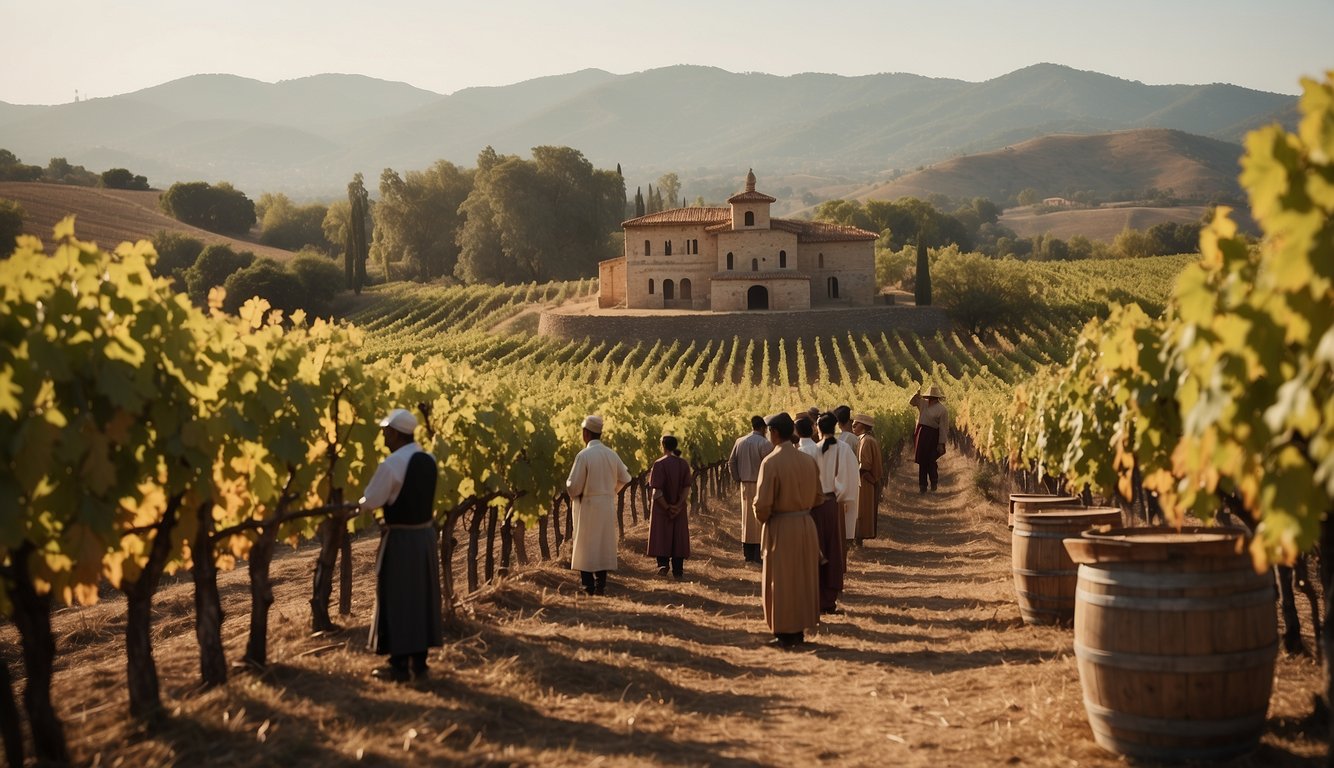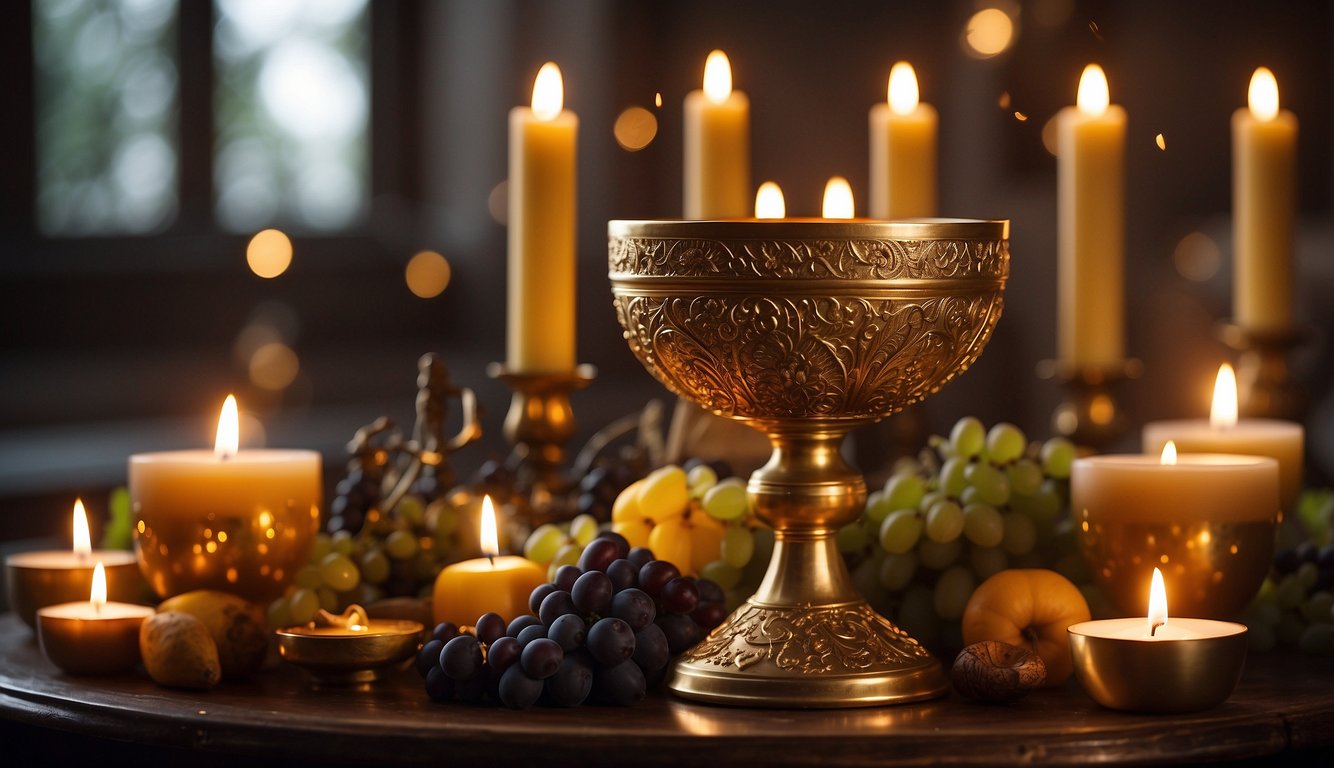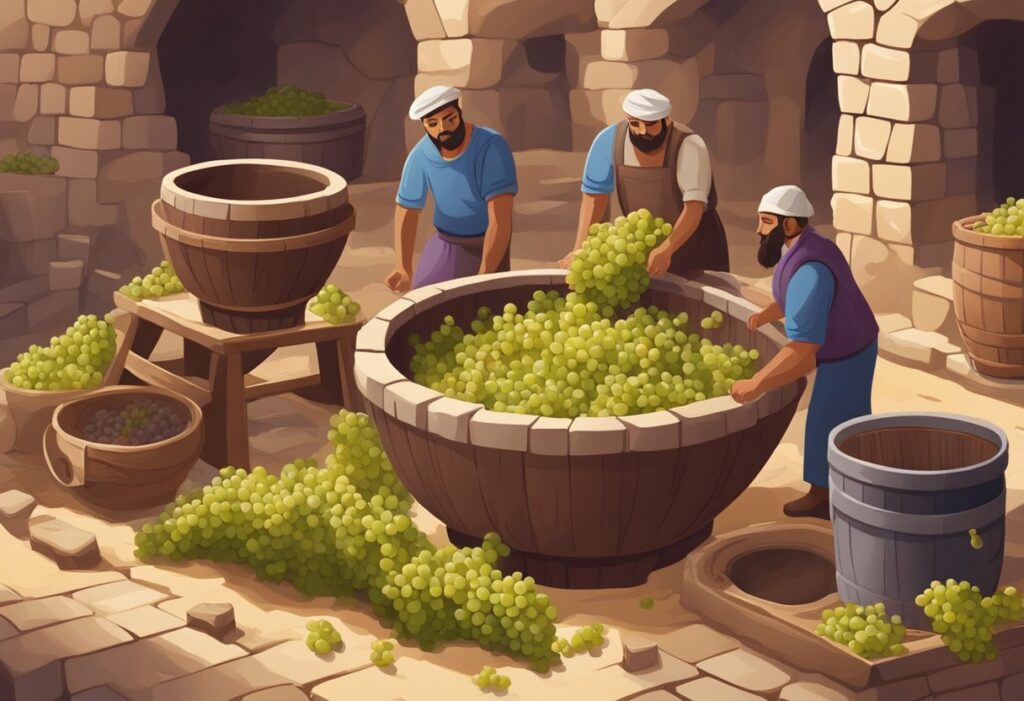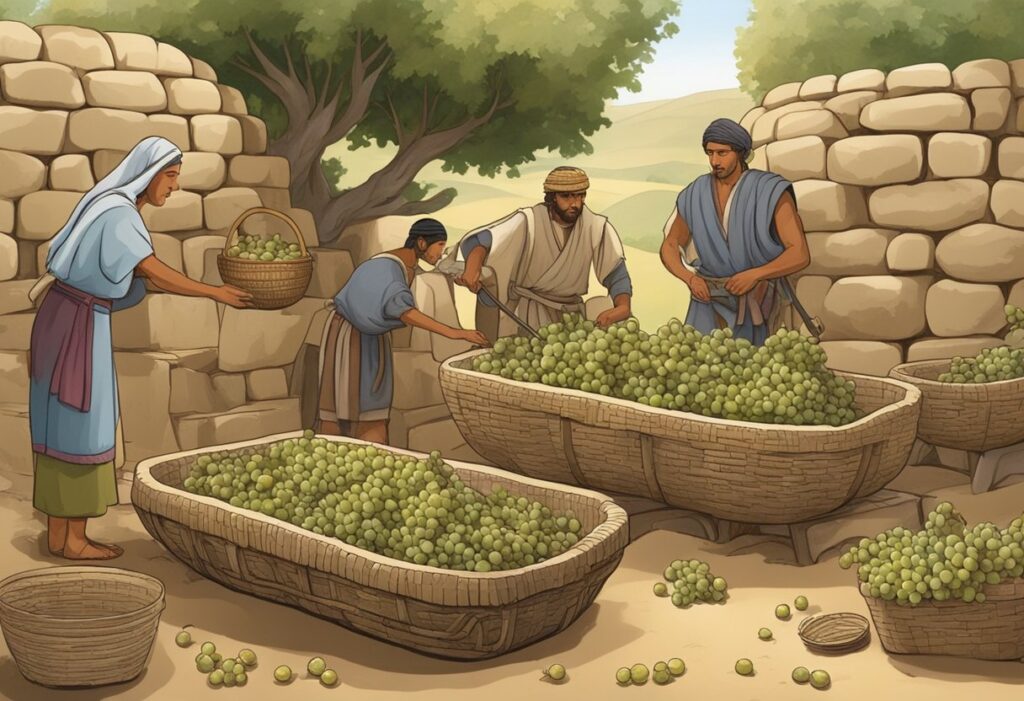Wine has been closely linked to religion since ancient times. In many cultures, wine not only plays a central role in rituals but also signifies sanctity and community. From the Egyptians, who honored gods like Hathor with wine, to the Greeks and Romans, who embedded wine into their social and religious practices, you’re stepping into a rich history that intertwines the spiritual and the everyday.

When you explore various religious traditions, you see wine’s symbolic power. For example, in Christianity, wine represents the blood of Christ during Communion, reflecting deep theological beliefs and communal unity. Similarly, in Judaism, wine is used to sanctify the Sabbath and other holidays, highlighting its importance in both ceremonial and daily life.
Knowing how wine spread across the ancient Mediterranean through cultural exchanges and colonization, you can appreciate its role not just as a beverage but as a connector of communities and traditions. Its journey from one civilization to another, becoming a staple in spiritual and social settings, offers a fascinating glimpse into how intertwined our histories are with the simple act of sharing a glass of wine.
Historical Significance of Wine in Religion
Wine has been intertwined with various cultures and religious practices. From ancient myths to modern sacraments, its importance is seen globally.
Wine in Ancient Ceremonies and Myths
In ancient times, wine was a key element in religious ceremonies. The Greeks and Romans often used wine in their rituals. The god of wine, known as Dionysus for the Greeks and Bacchus for the Romans, played a central role in their mythologies.
Ceremonies, like the Greek symposia, were more than drinking parties—they were religious gatherings. In Egypt, wine was part of the offerings to gods and pharaohs. Similarly, in Mesopotamia, wine was connected to divine acts and royal events, influencing the Neolithic period’s societal structures.
The Sacred Symbolism of Wine in Christianity
For Christians, wine holds a special place in religious practices. Jesus turned water into wine at the wedding at Cana, symbolizing divine power and blessing. During Communion, wine represents the blood of Jesus shed during the Crucifixion, an event central to Christianity.
The act of taking wine in Communion, called the Eucharist, is seen as a sacred moment of remembrance and connection with Jesus. It underscores the themes of sacrifice, unity, and celebration in Christian faith. The Franciscans and Jesuits were instrumental in spreading these rituals to the American colonies, including Plymouth Rock.
Judaism and the Ritualistic Use of Wine
In Judaism, wine is imbued with ritualistic significance. It is essential in various ceremonies, such as the Friday night Kiddush during Shabbat, which sanctifies the Sabbath. Passover seders also involve drinking wine to symbolize freedom and deliverance from Egypt.
Jewish festivals, like Purim, include joyful wine consumption, reflecting gratitude and celebration. Wine’s consistent presence in Judaic rituals emphasizes its importance in spiritual and everyday life. It is a symbol of sanctity and community, reinforcing its age-old religious role.
These examples reveal wine’s deep-rooted connection with spiritual practices across different cultures and times. This beverage, simple yet profound, continues to play a significant role in religious observances worldwide.
The Spread of Viticulture and Viniculture

The growth of wine cultivation has a rich history that spans across continents and centuries, influenced by different cultures and civilizations. Ancient trade routes played a crucial role in spreading wine from its origins to new lands.
Influence of Mediterranean Civilizations
The Mediterranean civilizations, especially the Phoenicians and Greeks, were pivotal in spreading viticulture. The Phoenicians were known for their extensive network of trade routes that crisscrossed the Mediterranean, touching regions like the North African coast and the Iberian Peninsula. They introduced grape cultivation to these areas and established early vineyards.
The Greeks further enhanced viticulture by not only cultivating grapes but also contemplating the philosophical aspects of wine. They spread these practices throughout Europe during their period of prosperity, laying the foundation for future wine-making techniques.
Wine’s Journey through Europe
Rome played a monumental role in advancing viticulture. Roman expansion brought wine to every corner of their empire, including modern-day Germany, France, and Spain. They established structured vineyards and developed efficient wine-making techniques.
The Romans focused on maximizing production to meet the growing demand brought about by their prosperity. This period saw significant advancements in wine storage, including the standardization of amphora shapes, each holding around 10, 20, or 30 liters, which were used in rituals and daily life.
The New World: From Pilgrims to Prohibition
The journey of viticulture did not stop in Europe. When European settlers arrived in the Americas, they brought vine cuttings with them. California became a prominent wine-producing region thanks to the favorable climate and soil.
During the Prohibition era in the United States, wine production declined sharply due to strict laws against alcohol. Despite this setback, the end of Prohibition saw a revival, and California emerged as a global leader in wine production, influencing wine styles and techniques worldwide.
The diverse and rich history of viticulture reflects how deeply intertwined wine is with the development of civilizations, trade routes, and cultural exchange.
Cultural and Religious Impact on Wine Making

Wine making has been influenced by various cultural and religious groups throughout history. Climate, soil, and religious practices have all played crucial roles in shaping the production and consumption of wine.
Religious Groups and Their Influence on Wine Production
Religious groups have significantly influenced the methods and traditions of wine production. For example, Jewish law has led to the production of kosher wine, which must be prepared under strict guidelines to maintain its spiritual purity. Christian practices also incorporate wine, especially during the Eucharist, where wine symbolizes the blood of Christ.
Ancient Greeks institutionalized wine-drinking in their symposia and Romans in their convivium, making it a staple in social and religious events. These practices contributed to the expansion of vineyards and innovations in wine-making techniques. Wine was not just a drink; it became a cultural history symbol deeply embedded in religious traditions.
The Intersection of Climate, Soil, and Sanctity
The climate and soil of a region heavily influence the quality and characteristics of wine. Mediterranean climates of places like Cyprus and Lesbos offer ideal conditions for growing grapes. The ancient production areas like those that produced Falernian wine were famous for their rich soil and favorable climates.
The sanctity of the land is often emphasized in religious texts, encouraging the cultivation of grapes on holy grounds. Specific soils and climates are believed to impart a sacred quality to the wine. For instance, vineyards on the island of Cyprus have been producing wine for centuries, drawing from the unique soil and climate of the region.
Throughout history, figures like Pliny the Elder have documented the importance of these elements in producing high-quality wine, showing that the intersection of natural conditions and religious significance shapes wine production.
Religious Practices and the Evolution of Alcoholic Beverages
Religious practices have played a crucial role in shaping the development of alcoholic beverages. Various traditions have influenced the types and uses of alcohol, leading to diverse cultural and spiritual practices.
From Sacred Wine to Beer and Beyond
Wine has held a sacred place in many religions. In Jewish tradition, wine is considered a holy drink and is used in rituals like Shabbat and Passover. During Christianity’s spread, wine became central to the New Testament‘s Eucharist, symbolizing the blood of Christ.
In ancient Egypt, wine was not only for the elite but also used in religious ceremonies dedicated to gods like Osiris. Beer, on the other hand, was common in Asian cultures and ancient Mesopotamia. Monks in Europe played an essential role in brewing beer during the Middle Ages, integrating it into their daily lives and celebrations.
Health, Medicine, and the Divine Origins of Wine
In ancient Greece, wine was not only a celebratory drink but also served medicinal purposes. Hippocrates, the famed physician, recommended wine for various ailments, showing its importance in early medicine. The Phoenicians, known for their trade across the Mediterranean, spread wine culture through amphorae filled with kos and Campania wines.
In the Levant region, especially Israel and Palestine, wine was integral to daily life and religious ceremonies. Archaeological discoveries have shown that wine production was advanced, with spices added for flavor and preservation. Even Alexander the Great found regional wines notable during his conquests.
Wine’s divine origins are also seen in myths and religious experiences. In the Caucasus, where wine is believed to have first been produced, it was often linked to celebrations and gods. Though some religions, like Islam, prohibited alcohol, others, like Christianity and Judaism, incorporated it into holy rituals, reflecting its deep connection to spirituality and culture.
Contemporary Manifestations of Wine in Religious Contexts

In modern times, wine continues to hold a significant place in religious practices. Christianity features wine prominently in the sacrament of Communion, representing the blood of Jesus Christ. Many churches ensure that their wine is specially certified for religious use, adhering to strict ecclesiastical standards.
Judaism also maintains the tradition of wine in religious contexts, particularly with kosher wines used during Shabbat and holidays. These wines are produced following Jewish dietary laws, ensuring their purity and ritual suitability.
Other religions, such as certain denominations within Islam, follow strict temperance rules, avoiding wine and other alcoholic beverages altogether. Yet, historical texts reveal that wine once played a part in celebrations and social gatherings in the early Islamic period.
Hinduism and Buddhism have varied approaches. While not commonly part of daily rituals, specific cultural traditions in these religions occasionally include wine in festivals and ceremonies, celebrating life and honoring the gods.
Pilgrims and religious groups often view wine not merely as a beverage but as a sacred symbol. This symbolism ties back to ancient mythology and the veneration of gods associated with wine cultivation and consumption.
You’ll find that contemporary wine consumption in religious settings balances tradition with modern interpretations. For example, the use of grape juice has become a common alternative in many Christian denominations, respecting the practice of temperance while preserving the symbolic act.
This ongoing relationship between wine and religion reflects a deep cultural and spiritual connection. These practices and adaptations illustrate how faith communities honor their heritage while navigating contemporary values and beliefs.

